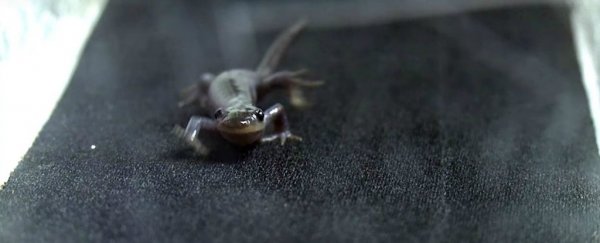Researchers have discovered that salamanders will risk their lives to find the right mate, walking up to 14 kilometres (9 miles) over rugged, inhospitable terrain on their stubby little legs if they have to.
That distance should kill these little animals, so to figure out how they pull it off, the team used a specialised, miniature treadmill to recreate the epic journey.
"It has to be incredibly intimidating for these tiny salamanders. They could get eaten by a crow or a racoon. They could dry out," said lead author Robert Denton from Ohio State University.
"This is the first study to connect physiological factors – particularly how fast they get tired of walking – with genetics showing animal movement in the field."
Understanding how these small salamanders travel such vast distances and what prompts them to do so is important if we want to know how environmental changes will affect their ecosystem in future.
Plus, how and why various animals travel to find mates is, as Denton puts it, a complex area of research that scientists are still learning a lot about.
The team was interested in understanding how salamanders – which are usually homebodies – create genetic diversity throughout their extensive habitats, and how they've developed such high levels of endurance.
After all, 14 kilometres (9 miles) might not seem that long for us humans, but it's an epic quest for something as small as a salamander.
"They're like endurance athletes. Some of them could walk for two-plus hours straight without tiring themselves," said Denton. "That's like a person lightly jogging for 75 miles [120 kilometres] before wearing out."
To start with, the researchers studied the genetic pool of mole salamanders, from the genus Ambystoma in various wetlands in Ohio, collecting and analysing 445 tail tip samples in the process.
These mole salamanders have an unusual reproductive strategy – there are populations that are sexual and include breeding males and females, and there are also asexual populations that are made up of all-female hybrids.
Those all-female hybrids don't need to go on epic journeys for sex, they simply need the sperm of a related species to kickstart the fertilisation process, and then ignore the sperm genome and develop asexually.
During the initial study, the team found that sexual salamander populations often ended up twice as far away from their place of birth as the all-female populations.
The team looked into whether there were any physiological differences between these two populations by taking 38 salamanders and seeing how far they could walk a specially designed treadmill in the lab.
How do you make a salamander walk on a treadmill? According to the team, it's quite easy.
The treadmill has a moving belt and is housed between two plastic walls to keep the small creatures from running off the sides. Then, the salamanders are prompted to walk with a small tap or a pinch of their tail.

Once the salamanders started their workout, the team watched closely for signs of fatigue, which was expressed when the salamanders refused to 'right' themselves after falling off the machine.
In the end, the team found that the sexual salamanders walked an average of four times longer than their asexual counterparts, with the average distance travelled by the sexual population being 9.6 kilometres (6 miles), and the longest travelled being 14 kilometres (9 miles).
"Maybe the best explanation for why sexual salamanders travel so far is because they have to: on a large landscape with few places to breed, the animals that can cross that distance are the ones that survive and reproduce," Denton said.
While the distance travelled by the sexual salamanders is definitely an exciting find for the researchers, the bigger question might be about why the asexual salamanders – which should be almost physiologically the same when it comes to walking – fatigued so quickly.
The team thinks it might have something to do with the lack of genetic diversity in the all-female population, seeing as they don't mix up their genes when they reproduce asexually.
"Perhaps the more interesting question is why the all-female salamanders don't go very far, and we think that has to do with the physiological costs of not having sex," Denton said.
"Essentially, not mixing up your genomic material often enough likely causes some problems for genes that you need to make energy."
With further research, the team might be able to discover more about the exciting sex lives of salamanders, and how their ability to walk long distances might help them keep a diverse genetic pool in their habitats.
Until then, check out the video below to see the salamanders getting their workouts:

The team's work was published in Functional Ecology.
